The Philippine Statistics Authority (PSA) generates production-related statistics on crops other than palay and corn through the Crops Production Survey (CrPS). This is a quarterly survey which aims to generate basic production statistics for crops at the national and sub-national levels. Twenty-one (21) major crops under the Other Crops sub-sector are highlighted in the Performance of Philippine Agriculture Report (PAR). It covers more than 280 crops sub-classified under three commodity groupings, namely: 1) Non-Food and Industrial Crops, 2) Fruit Crops, and 3) Vegetables. The commodity coverage by province differs and depends on what each province produces. After the collection and organization of statistics on Other Crops, these undergo a review and validation process before finally made available to data users.
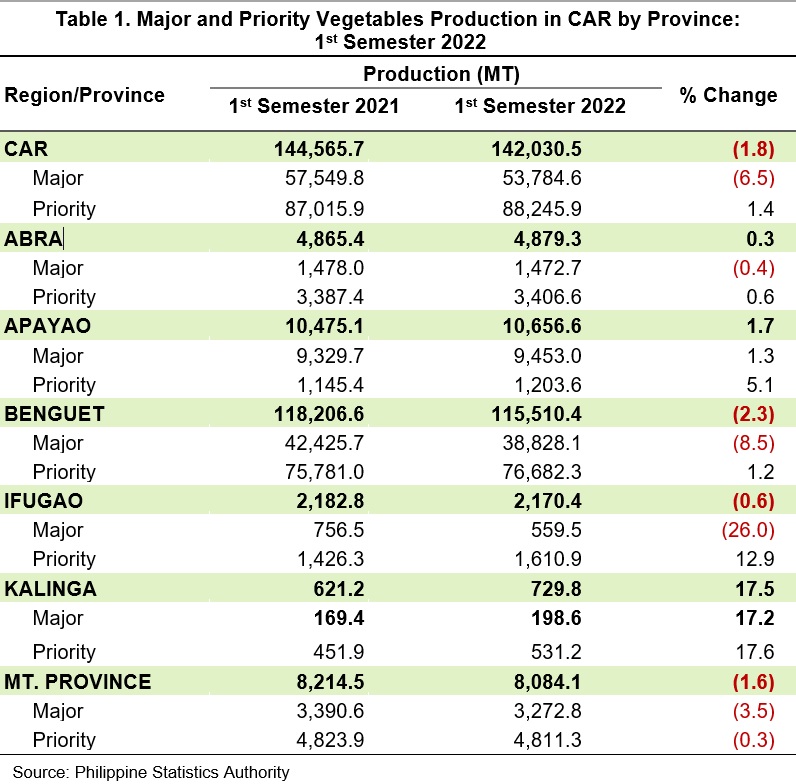
- The vegetables production of the Cordillera Administrative Region (CAR) decreased by -1.8% from 144,565.7 MT in the first semester of 2021 to 142,030.5 MT in the first semester of 2022. Benguet, Ifugao, and Mt. Province registered negative growths while, Abra, Apayao and Kalinga increased in production (Table 1).
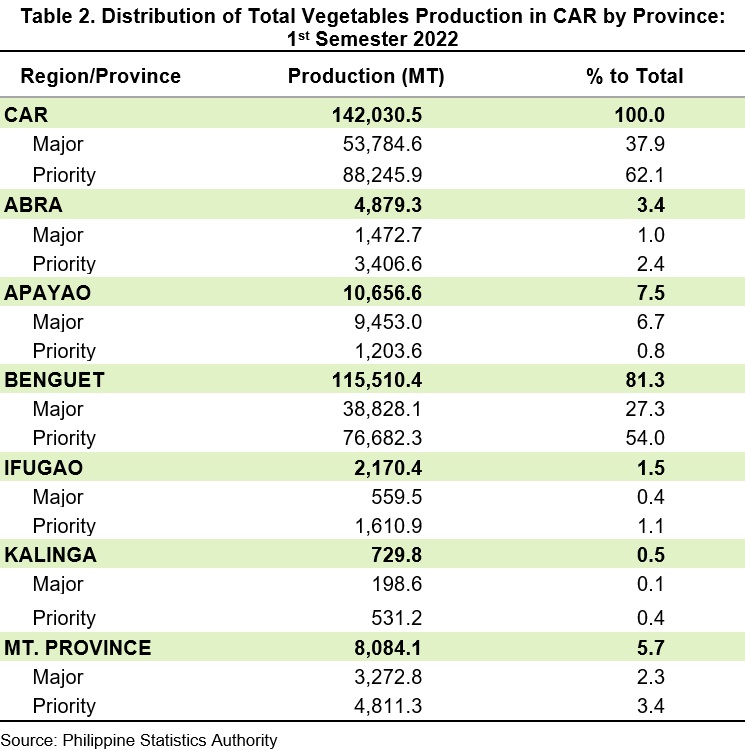
- Out of the first semester of 2022 total regional production of 142,030.5 MT, 88,245.9 MT (62.1%) came from priority vegetables and 53,784.6 MT (37.9%) came from major vegetables production (Table 2).
- Benguet was the top producer with 115,510.4 MT accounting the biggest share of the total regional vegetables production with 81.3%. Apayao distantly came second with 7.5% share, followed by Mountain Province with 5.7%, Abra with 3.4%, and Ifugao with 1.5% shares, respectively (Figure 1).
- Kalinga contributed the smallest share in the total vegetables production of the region with an output of 729.8 MT comprising 0.5 % of the total vegetables production in the region (Table 2).
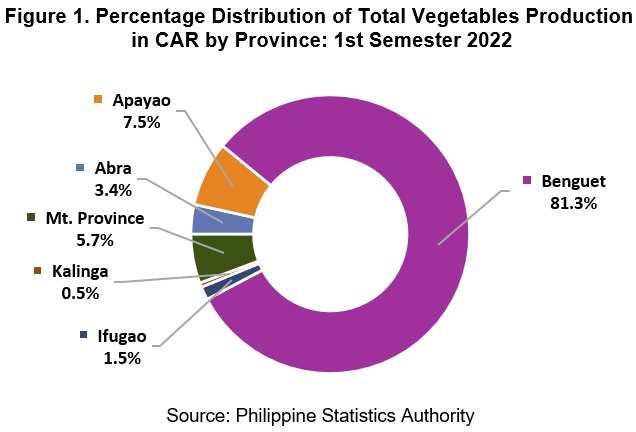
MAJOR VEGETABLE CROPS
- Major vegetable crops include mongo, ampalaya, cabbage, eggplant, tomato, potato, onion, camote and cassava.
- Cordillera major vegetables output in the first semester of 2022 was 53,784.6 MT comprising 37.9% of the total vegetables production of the region.
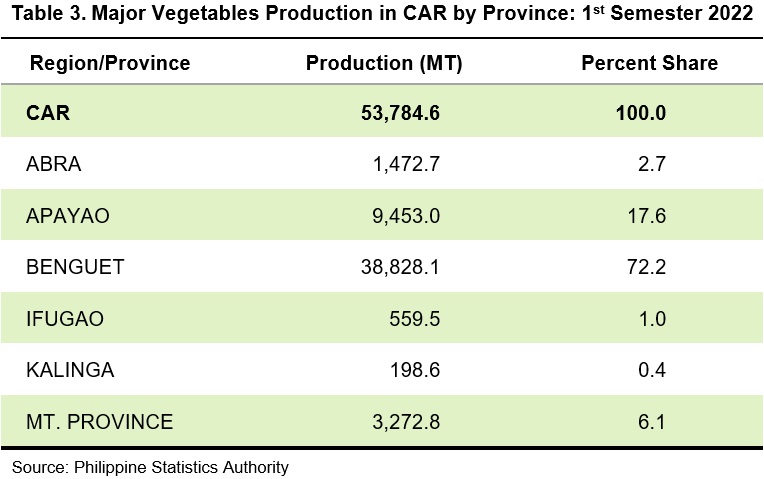
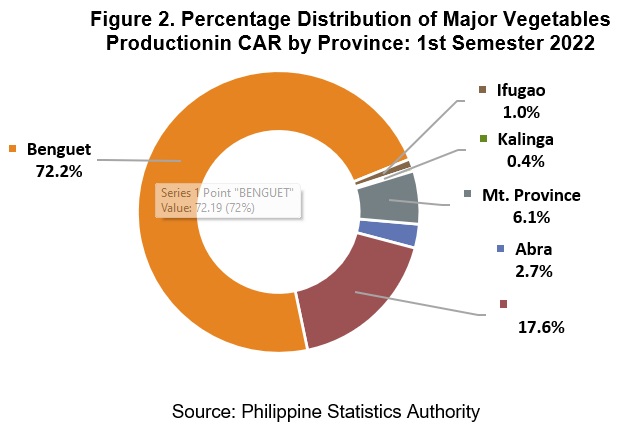
- Benguet was consistently the top major vegetables producing province with 38,828.1 MT of produce, comprising 72.2% of the major vegetables production. Apayao followed with 17.6% share. Mt. Province and Abra came third and fourth with 6.1% and 2.7% shares. The provinces with the smallest shares were Ifugao and Kalinga with 1% and 0.4% shares, respectively (Figure 2).
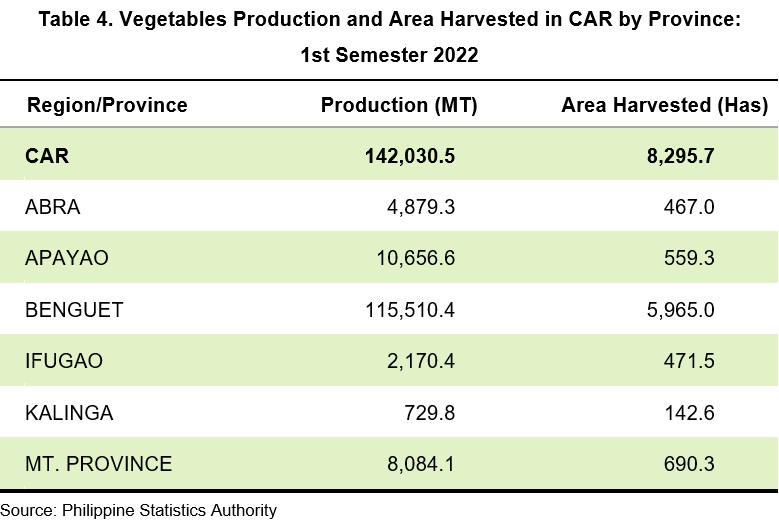
- In the 1st semester of 2022, CAR total vegetables production registered a volume of 142,030.5 MT with an estimated area harvested of 8,295.7 hectares. Priority vegetables dominated the region’s production accounting for 62.1% of the total vegetables production.
- Benguet province posted the highest volume of vegetables produced with 115,510.4 MT from an area harvested of 5,965 hectares. Apayao came second with 10,656.6 MT with an area harvested of 559.3 hectares while Kalinga had the least production in the region with only 729.8 MT with an area harvested of 142.6 hectares (Table 4).
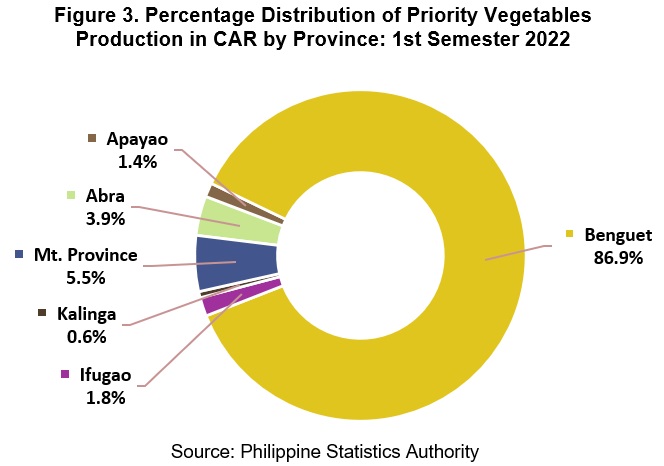
PRIORITY VEGETABLE CROPS
- Priority vegetable crops include habitchuelas, banana blossom, broccoli, cauliflower, kangkong, lettuce, pechay, peanut, stringbeans, gourd, okra, squash fruit, ginger, pepper, carrots, gabi, radish and garlic.
- In terms of percentage distribution in priority vegetables production in the region, Benguet contributed 86.9%. Mt. Province came second with 5.5% share. The other provinces and their shares to total priority vegetables production were Abra with 3.9%, Ifugao with 1.8%, and Apayao with 1.4%. Kalinga province had the smallest share with 0.6% (Figure 3).
---Technical Notes---
Production is the quantity produced and actually harvested for a particular crop during the reference period.
Vegetable Crops are mostly temporary crops which are either classified agronomically as such or based on purpose for which they are used.
Root Crops are well developed underground edible roots. They are classified into tubers and roots.
Area Harvested is the actual area which harvests are realized. This excludes crop area totally damaged.
Major Crops are the top 21 crops in the Philippines, other than palay and corn which collectively account for more than 60 percent of the total production.
Priority Crops are the identified national banner crops and various regional priority crops of the Key Commercial Crops Development Program (KCCDP), High Value Commercial Crops (HVCC) Program and now the Key Commodity Road Maps of the Department of Agriculture, which are being developed because of their industrial and commercial potentials.
Industrial Crops are crops that are used as inputs to other industries.
Non-Food Industrial Commercial Crop are crops other than those used for food consumption. These are crops grown for their aesthetic values such as ornamental plants and cut-flowers. These also include agriculture-derived products such as rice hay and coconut leaves.

